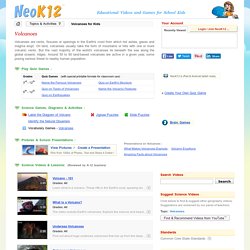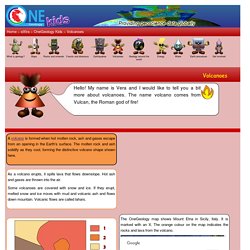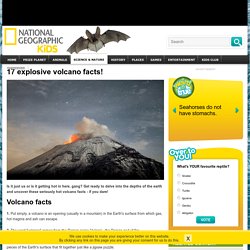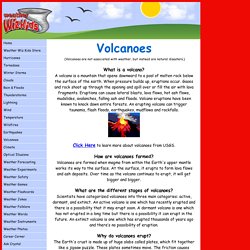

DK Find Out! - Volcanoes. Volcanic gas and ash › Volcanic gas and ash › An erupting volcano causes gas and sometimes ash to pour into the sky.

Volcanic gas and ash › How a volcano erupts › How a volcano erupts › When a volcano erupts, hot, liquid rock (magma) rises up and bursts out through an opening called a vent in Earth’s surface. How a volcano erupts › Types of volcano › Types of volcano › There are four main types of volcano: shield, stratovolcano, caldera, and cinder cone. Types of volcano › What is a volcano? What is a volcano? We often picture volcanoes as cone-shaped mountains. What is a volcano? Hot spots › Hot spots › Hot spots are thin patches of Earth’s crust where hot liquid rock (magma) breaks through. Hot spots › Lava › Lava › Magma is liquid (molten) rock from Earth’s interior. Lava › Where are volcanoes found? Where are volcanoes found? Most volcanoes are found near the boundaries of Earth's tectonic plates.
Volcanoes for Kids - Geography Games and Videos. Volcanoes for Kids Volcanoes are vents, fissures or openings in the Earth's crust from which hot ashes, gases and magma erupt.

On land, volcanoes usually take the form of mountains or hills with one or more volcanic vents. But the vast majority of the world's volcanoes lie beneath the sea along the global oceanic ridges. Around 50 to 60 land-based volcanoes are active in a given year, some posing serious threat to nearby human population. Play Quiz Games : NeoK12 is iPad & Android tablet ready. Science Games, Diagrams & Activities : Pictures & School Presentations : Science Videos & Lessons:(Reviewed by K-12 teachers) Search Videos Suggest Science Videos Click below to find & suggest other geography videos.
Topic : Volcanoes Standards Common Core State Standards Videos are embedded and streamed directly from video sites such as YouTube and others. NeoK12 makes learning fun and interesting with educational videos, games and activities for kids on Science, Math, Social Studies and English. OneGeology - Volcanoes. Hello!

My name is Vera and I would like to tell you a bit more about volcanoes. The name volcano comes from Vulcan, the Roman god of fire! A volcano is formed when hot molten rock, ash and gases escape from an opening in the Earth’s surface. The molten rock and ash solidify as they cool, forming the distinctive volcano shape shown here. As a volcano erupts, it spills lava that flows downslope. Some volcanoes are covered with snow and ice. Volcanoes are made of unique rocks called extrusive igneous rocks. Volcano Facts. 6.

Volcanoes are classified as active, dormant or extinct depending on the amount of volcanic activity happening. 'Active' means there's regular activity, 'dormant' means there's been recent activity but that it's currently quiet and 'extinct', meaning it's been so long since the last eruption that it's unlikely to ever erupt again. 7. When you imagine a volcano, you might picture it as a large, slope-sided mountain, but volcanoes can actually be a variety of shapes. Shield (flat), composite (tall and thin), cinder cones (circular or oval cones), and lava domes (where dome-shaped deposits of hardened lava have built up around the vent, as the lava is too thick to flow very far). 8. 9. 10. All About Volcanoes. Volcano information for kids. Volcanoes (Volcanoes are not associated with weather, but instead are natural disasters.)

What is a volcano? A volcano is a mountain that opens downward to a pool of molten rock below the surface of the earth. When pressure builds up, eruptions occur. Gases and rock shoot up through the opening and spill over or fill the air with lava fragments. Eruptions can cause lateral blasts, lava flows, hot ash flows, mudslides, avalanches, falling ash and floods. Click Here to learn more about volcanoes from USGS. How are volcanoes formed? What are plate tectonics? Click Here to learn more about plate tectonics and the drifting of our continents.